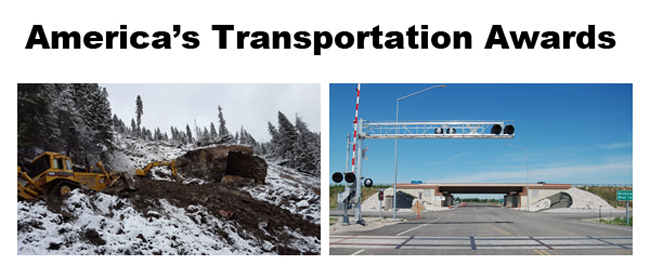

Idaho one of only two western states to win multiple regional awards
from national transportation organization
Two Idaho Transportation Department (ITD) efforts -- a massive clean up of a landslide in north-central Idaho, and the final piece of an interchange construction plan in eastern Idaho that significantly cut serious crashes -- won regional awards June 28 in Juneau, Alaska.
Regional winners in the America's Transportation Awards were announced during the annual conference of the Western Association of State Highway and Transportation Officials (WASHTO). Idaho was one of only two western states to receive multiple awards; Colorado was the other. WASHTO is the western regional arm of the American Association of State Highway and Transportation Officials (AASHTO).
"The America's Transportation Awards give state DOTs recognition for providing the essential connections that keep people, goods and our economy moving forward," said David Bernhardt, AASHTO president.
The two ITD awards are listed below:
Elk City Slide Cleanup – winner in “Operational Excellence, Small Project”
The 2016 Elk City landslide unleashed 47 million lbs. of mud, rock and debris on the State Highway 14, cut off access in and out of a remote Idaho town and threatened grocery and gas deliveries, health-care visits, emergency services, and the livelihood of those who rely on the highway for transport.
The landslide was enormous — the cleanup was equally daunting. The task had a once-in-a-career magnitude. ITD crews rose to the challenge.
ITD employees from all over the state swarmed to the site to respond. Many employees took leave of their typical job assignments to assist in the efforts.
The original slide Feb. 18, 2016 loosened more than 100,000 cubic yards of material, 20 feet deep in places, dumping material across a 500-foot-wide stretch of Idaho 14 and closing the road. Two months later, a second slide brought down more material and pushed what was already loose debris even closer to the highway. Combined, the slides spilled 235,000 cubic yards of debris on the road and left a boulder weighing about 2.4 million lbs. on the hillside that ITD reduced with two dynamite charges.
The cleanup took about six months, and cost close to $3.5 million (federal emergency-relief funds).
“The Elk City Slide was a true collaboration of efforts amongst many dedicated and focused team players,” said ITD District 2 Engineering Manager Doral Hoff. “The primary emphasis was to restore some semblance of mobility back to State Highway 14 and service to Elk City, even if that was only going to be one lane for a time.”
“We included and aligned all facets of district personnel, which included all workers and foremen alongside people from ITD’s Headquarters and the contractor West Construction Company, to make this effort successful. The entire team worked safely and efficiently, with the people of Elk City in mind every step of the way.”
U.S. 20 Thornton Interchange – winner in “Best Use of Technology & Innovation, Small Project”
The opening of the new Thornton Interchange in eastern Idaho south of Rexburg in mid-November 2016 marked the culmination of more than a decade of U.S. 20 safety improvements. This section of four-lane, divided highway was prone to vehicle crashes due to a series of at-grade intersections. Thornton was the last of seven new interchanges built in a 34-mile stretch of U.S. 20 between Idaho Falls and Sugar City to improve access management and traffic flow for greater highway safety and mobility.
Despite traffic volumes more than doubling, these improvements decreased the rate of serious-injury crashes by 75 percent and cut fatalities to less than one per year. Serious-injury crashes in the highway corridor have dropped from an average of 80 in 2000 to 38 in 2015.
Since 2000, the average number of vehicles on the four-lane divided highway increased from 10,000 to 21,500 per day, and the speed limit increased from 55 mph to 65 mph, and has since increased to 70 mph.
The project also featured several money-saving innovations and technological advances like 3-D modeling, Automated Machine Guidance, Global Positioning Satellite to ensure compliance with proper elevations during construction, and Bluetooth detection to maximize safe and efficient traffic flow through the work zone during construction. ITD also used a 360-degree camera and three stationary cameras during construction to monitor progress.
The innovations shaved at least $450,000 off the final price tag for the Thornton project.
“Providing the contractor with a 3-D model for the Thornton Interchange and requiring them to use automated grade control during construction shortened the required construction time,” said ITD District 6 Engineering Manager Wade Allen. “We reduced the impact to traffic by keeping two lanes open in each direction of travel through the busiest part of the summer.”
Published 06-30-17